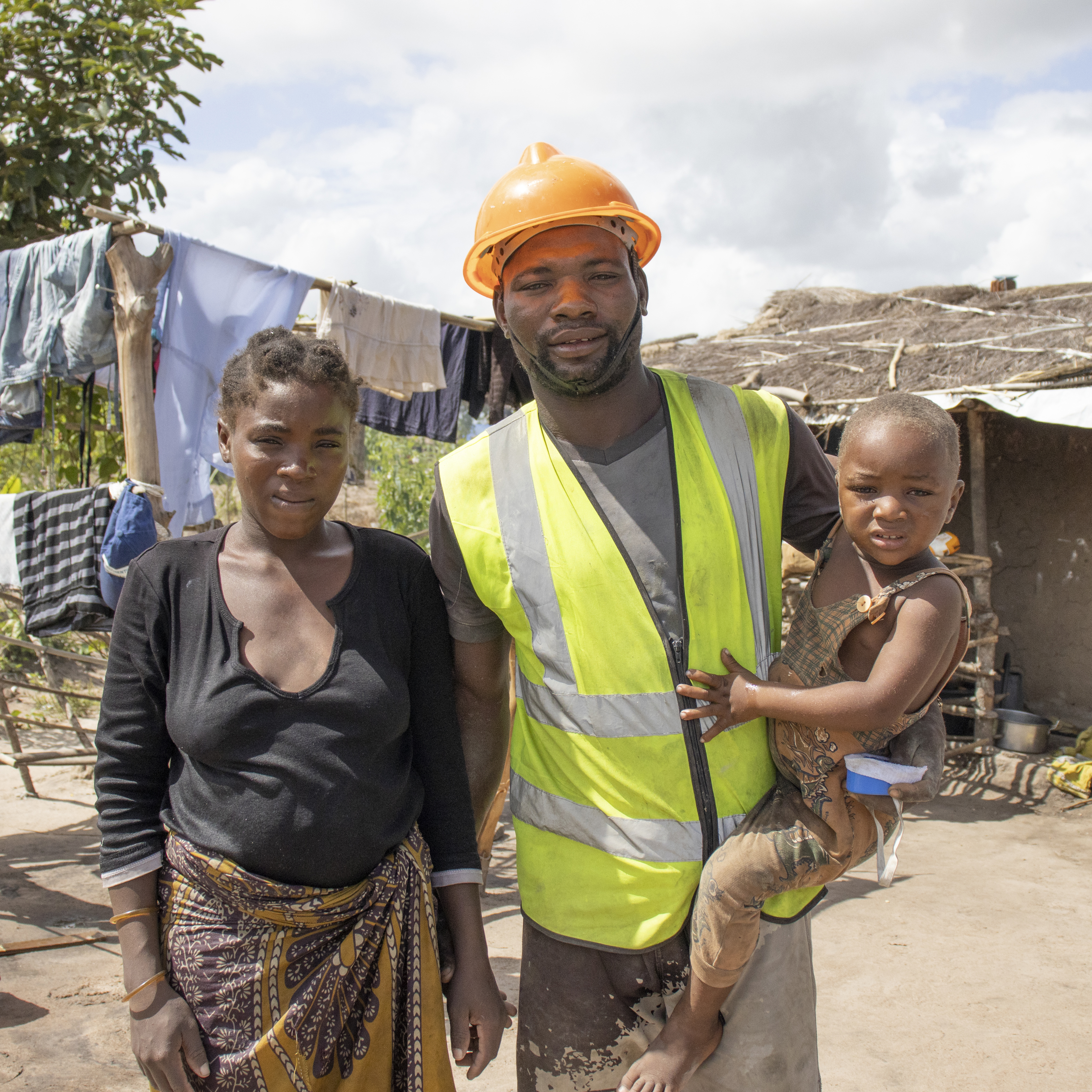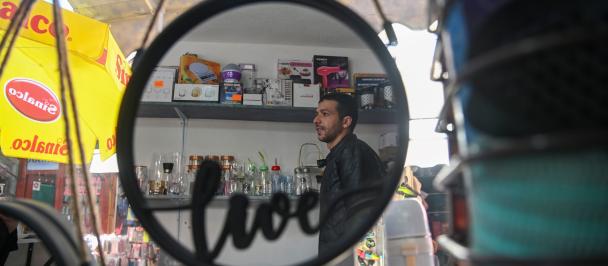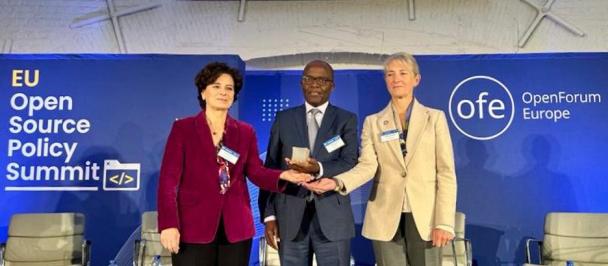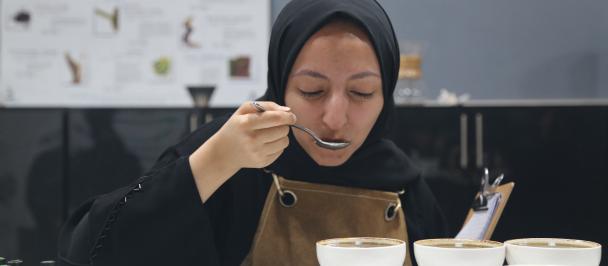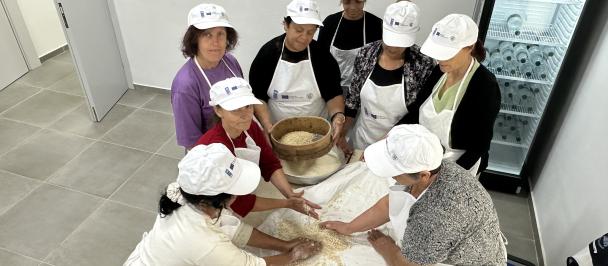Gino Francisco Alban and his family, residents of the resettlement, who participated in the construction of the market with support from the UNDP Recovery Facility., funded by the EU and partners. Photo: UNDP Mozambique/Brenda Hada
"This is where I will live, make a living, to produce, sell, eat. [...] The market will be an improvement to make our life here", reports Eugenia Oraibo, community leader and one of the thousands of displaced people after Cyclone Idai in 2019, in Sofala Province, Mozambique.
Eugenia celebrates the recent opening of the Savane Resettlement Neighborhood Market, inaugurated on 13 October 2020, the International Day for Disaster Risk Reduction. The emblematic event for the local community was attended by the Governor of Sofala, Mr. Lourenço Ferreira Bulha, and the European Union (EU) Ambassador, Mr. Antonio Sánchez-Benedito Gaspar. The work is the result of joint efforts by the United Nations Development Programme (UNDP) and the Post-Cyclone Reconstruction Office (GREPOC), with financial support from the EU through UNDP Mozambique Recovery Facility (MRF).
Speaking at the inauguration, the EU Ambassador affirmed that he “wanted to hear and see everything that is being undertaken as efforts to reconstruct and consolidate peace, and also to account for what our commitments, as the European Union, were to the Sofala province after the cyclones and with regard to peace-building. From what I saw, I can say that we have results and we will continue to move forward as there is still much to do”.
It is estimated that the market will directly benefit 1,191 residents in the region, many of whom are still struggling to resume business in safer locations. Note that for the recovery of livelihoods in the Savane resettlement area, 5,000 vulnerable families have received diverse assistance through income generation activities and small businesses development from UNDP MRF, including the construction of a fishpond, cleaning of agricultural fields, opening of waterways and road access, construction of energy-efficient stoves, from which 92 savings and credit groups were created, totaling 2,694 members, of which 1,894 were women. In addition to a community loan initiative, 1,500 kits for income generation and small business activities were delivered to the community, reaching 1,600 beneficiary families.
“The construction of this market started in April, under the UNDP’s Mozambique Recovery Facility Program, with funding from the program's largest among the seven donor partners, the European Union. This is one of the three markets completed. These markets were designed and built according to the ‘Build Back Better’ resilient construction standards and with a view to the sustainable use of this space, which includes water supply through rainwater collection as well as electricity through renewable energy”, reported Mr. Ghulam Sherani, head of the UNDP field office and coordinator of MRF in Beira, on behalf of the UNDP Resident Representative. “In addition, the work counted on the contribution of the masons and artisans of Savane’s resettlement site and host communities, who were trained in resilient construction techniques in 2019 by UNDP, with 30% theoretical and 70% practical training. The community participants organized themselves into smaller shifts and groups to maximize the opportunity of work in a safe and healthy way, and to support the construction of the Market for their community. Their work made the Market a reality in the midst of COVID-19 challenges”, he concluded.
"We are making the market to serve all of us. We needed a market, so we are very eager. Market was far away from here. Now we will be able to resume even better what we were selling on the beach, before the Cyclone. [. ..] I already feel confident in learning and I have already built my house. The rain is falling and nothing bad happens", tells Gino Francisco Alban, resident of the resettlement, bricklayer participating in the constructions and trained by the UNDP Recovery Facility.
“We are proud to be present here to proceed with the inauguration of this infrastructure. This building is resilient and must be well taken care of”, said the Governor of Sofala Province. “The European Union provided us with funds through the United Nations Development Program (UNDP), in order to realize this dream that we all have the opportunity to witness. To the Government of the District of Dondo, our greetings go for the space and the monitoring of the works until their completion.”
The senior coordinator of GREPOC, Mr. Zefanias Chitsungo, stressed: “Today, we witness the delivery of yet another work resulting from the post-cyclone reconstruction program through the Mozambique Recovery Facility a directly implementation project of UNDP in compliance with the norms and standards of quality and resilience. This infrastructure was built respecting the rules to tackle COVID-19: it is equipped with toilets, a hand washing point to ensure the hygiene of users and vendors. […] The population of Savane is to be congratulated, the province of Sofala is to be congratulated; we call for the good use and conservation of the infrastructure and best wishes for success in the recovery activities and livelihoods resulting from this.”
I really liked that we have a market. I'm going to do my bread business here”, says Angélica Rafael, 43 years-old, beside her daughter and granddaughter. She is the head of a seven-member family.
***
In 2020, Mozambique Recovery Facility is assisting more than 53,143 families (more than 270,000 people) with sustainable livelihood recovery activities, which include temporary employments, community productive infrastructure rehabilitation, skills trainings, initiation of small businesses, creation of savings groups, and the delivery of kits for self-employment. Additionally, the MRF is reconstructing and rehabilitating 10 schools (8 Primary and two Secondary), 1,000 houses, four government offices and one hospital. In addition to the European Union, the Recovery Facility counts on financial support from Canada, China, Finland, India, the Netherlands and Norway.

 Locations
Locations